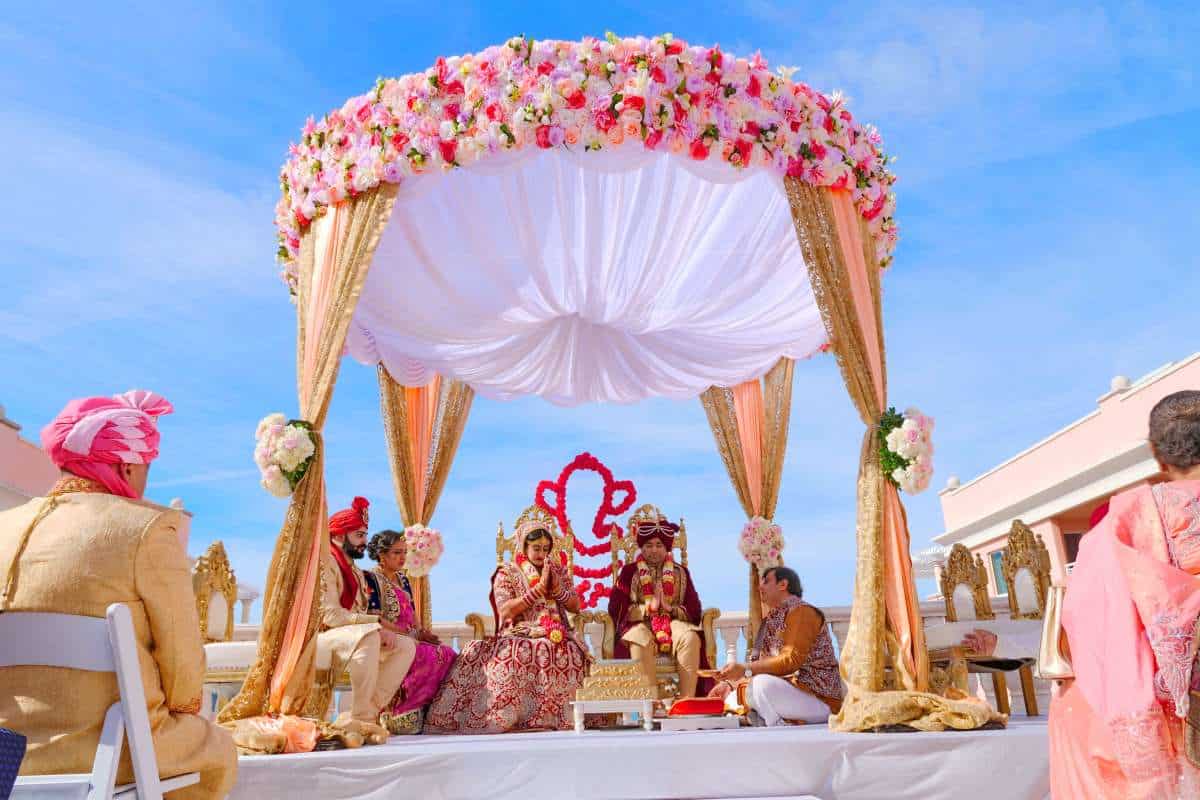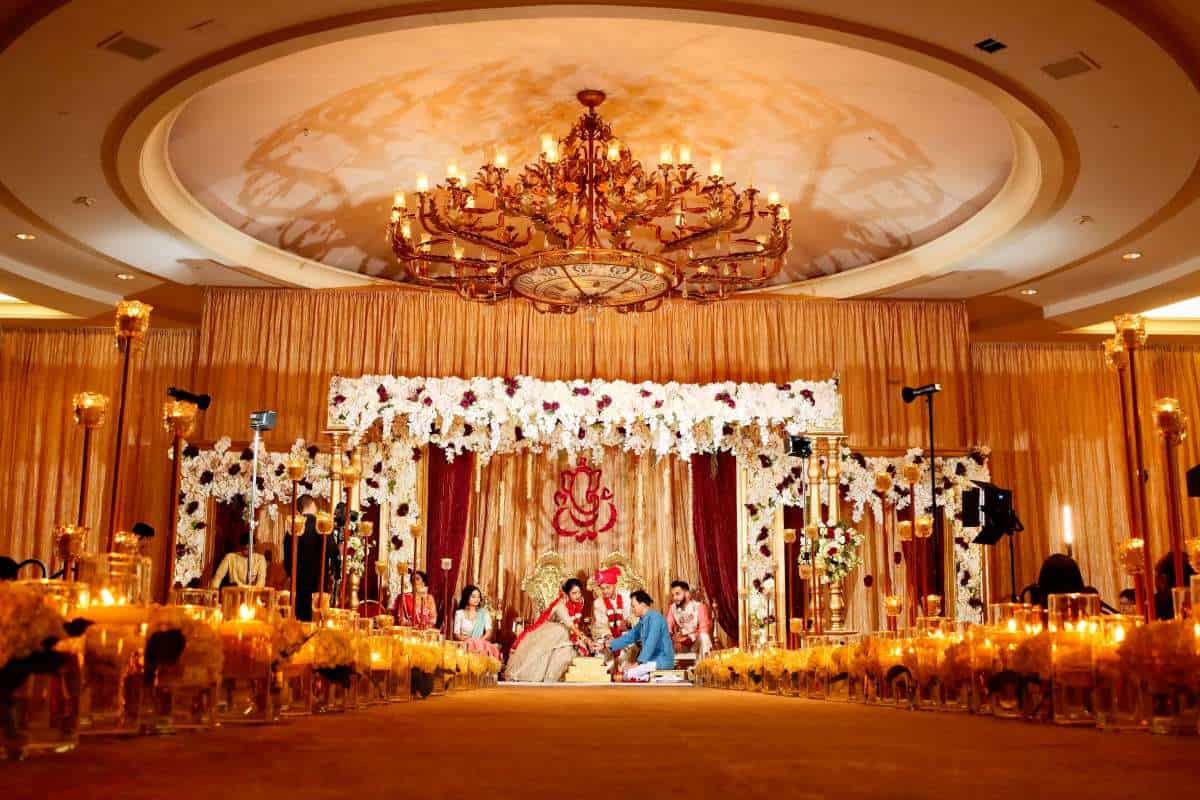Indian weddings are truly one of a kind. If you’ve been invited to one, you’re in for a memorable experience. These celebrations are lavish, vibrant, and steeped in tradition, often spanning several days.
If you’re from Australia or another Western country, you might find yourself wondering, “What should I wear to an Indian wedding?” This question is common among Western guests attending these grand events for the first time.
To help you navigate the exciting world of Indian weddings, we’ve put together a guide to ensure you’re both stylish and respectful.
Let’s get straight to the point
For a Westerner attending an Indian wedding, it’s important to embrace the vibrant, festive spirit while respecting cultural customs. You can choose between traditional Indian attire (like sarees or sherwanis) or modest Western outfits.
Bright colours like pink, yellow, and jewel tones are encouraged, while white, black, and red should be avoided. Women should cover shoulders and legs, and men should wear long-sleeved shirts and trousers.
Accessories like bold jewellery and comfortable footwear are key. Overall, focus on being respectful, comfortable, and stylish to fully enjoy the celebration.
Choosing the Right Outfit for an Indian Wedding
Traditional vs. Western Attire
The first decision you’ll face is whether to wear traditional Indian attire or stick with something Western.
While it’s not mandatory to wear traditional clothing, many guests choose to embrace it as a way to celebrate the culture. This choice can enhance your experience and help you feel like a part of the festivities.
Traditional Indian Clothing
For women, common choices include:
- Sarees: This is a long piece of fabric, often made of silk, that is draped elegantly around the body. The saree is a timeless option and one of the most traditional choices for an Indian wedding.
- Lehengas: This ensemble consists of a fitted blouse and a flared skirt, often heavily embroidered. It’s another beautiful and culturally significant option.
For men, the go-to traditional garment is the Sherwani, a long coat-like tunic usually worn over trousers. It’s stylish and fits well with the festive atmosphere of the wedding.
Western Attire: Can You Wear It?
If traditional clothing isn’t your style, don’t worry. You can still attend an Indian wedding in Western attire.
However, it’s important to be mindful of a few key cultural nuances.
- Women: Opt for long dresses or pantsuits. These should be modest and avoid exposing too much skin. Long sleeves or covering your shoulders is often recommended, especially for the religious ceremony.
- Men: A suit or formal shirt and trousers are appropriate. Avoid black and white, as these colours have negative associations with Indian culture (more on this below).
Colours: What Works and What to Avoid
Embrace Vibrant Colours
Indian weddings are all about vibrancy and joy, and your attire should reflect that.
Bright colours like pink, yellow, orange, green, and blue are all fantastic choices. These shades symbolise happiness and prosperity, making them ideal for such a festive occasion.
- For daytime events, softer pastels can be a great choice.
- For evening receptions, rich jewel tones like emerald green, royal blue, and deep maroon will fit the grandeur of the event.
Colours to Avoid
While vibrant colours are encouraged, there are a few shades that are culturally inappropriate for an Indian wedding:
- White: In many parts of India, white is associated with mourning and funerals, not celebrations. Therefore, it’s best to avoid this colour, especially during the ceremony.
- Black: Black is often considered inauspicious at Indian weddings. While it’s a staple at Western formal events, it’s not a suitable colour for Indian nuptials.
- Red: This colour is traditionally reserved for the bride. While it’s not completely off-limits, it’s respectful to let the bride shine in red.
Modesty: Covering Up
In line with cultural norms, it’s important to dress modestly for an Indian wedding, particularly during the religious ceremonies.
Guidelines for Women
- Cover your shoulders: If you’re not wearing a saree, make sure your dress or top covers your shoulders.
- Legs and arms: Opt for outfits that cover your legs and, if possible, your arms as well. A long dress or pantsuit works perfectly.
- Avoid revealing clothes: Clothing that is too tight or exposes too much skin is generally frowned upon. Indian wedding attire is typically flowy and modest, so aim for outfits that are both comfortable and appropriate.
Guidelines for Men
- Long sleeves: Men should wear long-sleeved shirts or jackets, especially for religious ceremonies.
- Trousers: Always opt for long trousers, as shorts would be seen as too casual and inappropriate.
Dressing for Specific Wedding Ceremonies
Indian weddings typically consist of multiple events over a few days, each with its own atmosphere and customs. The dress code can vary depending on the specific ceremony.
The Wedding Ceremony
This is the most formal part of the wedding, often taking place in a temple or under a traditional canopy.
Men and women should dress conservatively, and women may be required to cover their heads if the ceremony is in a Sikh or Hindu temple. Bringing a scarf or shawl is a good idea for this reason.
The Reception
The reception tends to be more relaxed compared to the ceremony, so you can afford to be a bit more playful with your outfit.
Women often switch to a lighter, more festive outfit for the evening, while men can opt for something more comfortable if they’ve been in a traditional sherwani all day.
Accessories: Elevate Your Outfit
No Indian wedding look is complete without accessories. Jewellery is an essential part of Indian culture, and weddings are the perfect time to go all out with your accessories.
Jewellery for Women
- Bangles: These are a must-have at Indian weddings. The more, the merrier!
- Earrings and Necklaces: Go for bold and bright jewellery to complement your outfit.
- Bindis: Women can also wear a bindi, a decorative forehead sticker. This is common and often adds a unique touch to your look.
Jewellery for Men
Men can also accessorise by wearing a turban or a headpiece if they are participating in a traditional ceremony. Gold or silver bracelets can also be worn as part of the attire.
Footwear: Practicality Meets Style
Indian weddings involve a lot of movement, from dancing to standing during long ceremonies. Comfortable yet stylish footwear is key.
For Women
Opt for comfortable flats or sandals, as you might be standing or sitting on the floor for long periods during the ceremonies. High heels are great for the reception but may not be practical for the whole event.
For Men
Men should go for closed-toe shoes that are formal but comfortable. Avoid overly casual footwear like sneakers unless explicitly allowed.
Conclusion
Attending an Indian wedding as a Westerner, especially as an Australian, is a unique opportunity to immerse yourself in a different culture.
The most important takeaway is to embrace the vibrant colours, respect the traditions by dressing modestly, and have fun with your attire.
Whether you choose to wear a traditional Indian outfit or opt for Western clothing, make sure you feel comfortable and confident.
Accessories like bangles, jewellery, and headpieces will elevate your look and help you blend in with the festive crowd.
With these tips, you’ll be dressed to impress and ready to enjoy the stunning celebration of love, culture, and tradition that defines an Indian wedding.
Frequently Asked Questions
What happens at a Indian wedding?
The reception is where the couple’s families will throw a lavish reception party to finally let loose. Part of the celebration includes speeches and loved ones singing, dancing and performing routines for the couple. Following this, a huge sit-down dinner and a dance party will take place.
Who pays for an Indian wedding?
It’s mostly split between the couple and their parents, 50/50. Sometimes, however, if one side is insisting on more guests or extra fanfare, then those costs are adjusted.
How long does an Indian wedding last?
A typical Indian wedding timeline stretches about three days. The Hindu wedding ceremony, which takes place on the third day, usually lasts between one-and-a-half to two hours and is then followed by the reception. The whole day clocks around 16 hours.
What is the most common tradition of wedding in India?
Ceremonies in Hinduism. While there are many festival-related rituals in Hinduism, vivaah (wedding) is the most extensive personal ritual an adult Hindu undertakes in his or her life. Typical Hindu families spend significant effort and financial resources to prepare and celebrate weddings.
What is done in an Indian wedding?
Every wedding guest is usually invited, and it involves an introduction of the couple’s families, mingling, a meal and dances or other performances. On the third day, the main ceremony, cocktail hour and reception take place. You may be invited to the last day of the events, or to any part of the three-day celebration.



